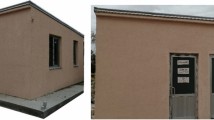Abstract
Recent research has shown that acoustics can be used to suppress flames from a liquid fuel source. The results of these experiments indicated that acoustics alone are insufficient to control flames beyond the incipient stage. Recent research has also shown that variations in the delivery of water mist to a fire can enhance the mist’s efficiency. Therefore, the addition of acoustics to water mist may be an effective means of enhancing an established fire protection technology. For the first time, acoustics and water mist have been combined and studied as a flame suppression strategy. A series of experiments were conducted that explored the potential for coupling acoustics with water mist as means of flame suppression. Heptane fueled flames were created from two different sized ceramic fiber wicks: 30 mm × 50 mm with 5 mL of fuel, and 60 mm × 100 mm with 20 mL of fuel. The flames were then exposed to water mist delivered at a constant rate, which was found to be incapable of suppressing the flames. Next, low frequency sound waves at 62 Hz and 80 Hz were used to suppress flames from both wicks, with each frequency being generated by a different resonator. Finally, acoustics from both resonators were combined with water mist, and used to suppress flames from both wicks. The results showed that a combination of acoustic waves and water mist suppressed the flames more effectively than each individual technique on its own. This finding opens the possibility of developing more efficient ways to use water mist technology.






Similar content being viewed by others
References
Liu Z, Kim AK (1999) A review of water mist fire suppression systems—fundamental studies. J Fire Protect Eng 10(3):32–50
Mawhinney J, Dlugogorski B (1994) A closer look at the fire extinguishing properties of water mist. Fire Saf Sci 4: 47–60
Mawhinney JR, Back III GG (2016) Water mist fire suppression systems. In: Hurley MJ (ed) SFPE handbook of fire protection engineering, 5th edn. Springer, New York, pp 1587–1645
Yoshida A, Okawa T, Ebina W, Naito H (2015) Experimental and numerical investigation of flame speed retardation by water mist. Combust Flame 162(5):772–1777
Gupta M, Pasi A, Ray A, Kale S (2013) An experimental study of the effects of water mist characteristics on pool fire suppression. Exp Thermal Fluid Sci 44(Suppl C):768–778
Liu J, Liao G (2011) Experimental study of the effect of water mist on CH4/air non-premixed flames. Proc Eng 26(Suppl C): 1279–1286
Lentati A, Chelliah H (1998) Dynamics of water droplets in a counterflow field and their effect on flame extinction. Combust Flame 115(1):158–179
Gagnon RM (2008) Design of special hazard and fire alarm systems, 2nd edn. Delmar, Clifton Park
Feng M-H, Tao J-J, Qin J, Fei Q (2011) Extinguishment of counter-flow diffusion flame by water mist derived from aqueous solutions containing chemical additives. J Fire Sci 34(1):51–68
Mawhinney JR (2008) Water mist fire suppression systems. In: Cote AE (ed) Fire protection handbook, vol 2, 20th edn. National Fire Protection Association, Quincy
Yu H-Z, Zhou X, Carpenter J (2017) Physical scaling of water mist fire extinguishment in industrial machinery enclosures. Fire Saf J 91:596–605
Grant G, Brenton J, Drysdale D (2000) Fire suppression by water sprays. Progr Energy Combust Sci 26(2):79–130
National Fire Protection Association (1994) In: Solomon RE (ed) Automatic sprinkler systems handbook. National Fire Protection Association, Quincy
Rasbash D (1986) The extinction of fire with plain water: a review. Fire Saf Sci 1:1145–1163
Yu H-Z, Newman JS (2008) Theory of fire extinguishment. In: Cote AE (ed) Fire protection handbook, vol 1, 20th edn. National Fire Protection Association, Quincy
National Fire Protection Association (2017) NFPA 750: standard on water mist fire protection systems. In: National fire codes. National Fire Protection Association, Quincy
White JP, Verma S, Keller E, Hao A, Trouvé A, Marshall AW (2017) Water mist suppression of a turbulent line fire. Fire Saf J 91(Suppl C): 705–713
Rasbash DJ, Rogowski ZW, Stark GWV (1960) Mechanisms of extinction of liquid fires with water sprays. Combust Flame 4:223–234
Braidech MM, Neale JA, Matson AF, Dufour RE (1955) The mechanism of extinguishment of fire by finely divided water: an investigation conducted for the national board of fire underwriters. Committee on Fire Prevention and Engineering Standards, Research Division, Underwriters’ Laboratory and National Board of Fire Underwriters, New York
Vilfayeau S, Myers T, Marshall A, Trouvé A (2017) Large eddy simulation of suppression of turbulent line fires by base-injected water mist. Proc Combust Inst 36(2): 3287–3295
Qin J, Chow W (2013) Experimental data on water mist suppression. Proc Eng 62:868–877
Yu H (2011) Physical scaling of water mist suppression of pool fires in enclosures. Fire Saf Sci 10:145–158
Friedman AN, Stoliarov SI (2017) Acoustic extinction of laminar line-flames. Fire Saf J 93:102–113
Friedman AN (2016) Interaction of acoustic waves with a laminar line-flame. University of Maryland, Theses and Dissertations, College Park
Author information
Authors and Affiliations
Corresponding author
Additional information
Publisher's Note
Springer Nature remains neutral with regard to jurisdictional claims in published maps and institutional affiliations.
Rights and permissions
About this article
Cite this article
Friedman, A.N., Danis, P.I., Fiola, G.J. et al. Acoustically Enhanced Water Mist Suppression of Heptane Fueled Flames. Fire Technol 54, 1829–1840 (2018). https://doi.org/10.1007/s10694-018-0777-0
Received:
Accepted:
Published:
Issue Date:
DOI: https://doi.org/10.1007/s10694-018-0777-0




